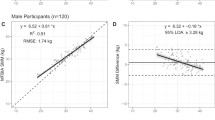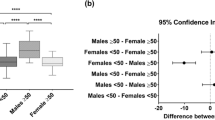Abstract
OBJECTIVE: To use magnetic resonance imaging (MRI) to validate estimates of muscle and adipose tissue (AT) in lower limb sections obtained by dual-energy X-ray absorptiometry (DXA) modelling.
DESIGN: MRI measurements were used as reference for validating limb muscle and AT estimates obtained by DXA models that assume fat-free soft tissue (FFST) comprised mainly muscle: model A accounted for bone hydration only; model B also applied constants for FFST in bone and skin and fat in muscle and AT; model C was as model B but allowing for variable fat in muscle and AT.
SUBJECTS: Healthy men (n=8) and women (n=8), ages 41–62 y; mean (s.d.) body mass indices (BMIs) of 28.6 (5.4) kg/m2 and 25.1 (5.4) kg/m2, respectively.
MEASUREMENTS: MRI scans of the legs and whole body DXA scans were analysed for muscle and AT content of thigh (20 cm) and lower leg (10 cm) sections; 24 h creatinine excretion was measured.
RESULTS: Model A overestimated thigh muscle volume (MRI mean, 2.3 l) substantially (bias 0.36 l), whereas model B underestimated it by only 2% (bias 0.045 l). Lower leg muscle (MRI mean, 0.6 l) was better predicted using model A (bias 0.04 l, 7% overestimate) than model B (bias 0.1 l, 17% underestimate). The 95% limits of agreement were high for these models (thigh,±20%; lower leg,±47% ). Model C predictions were more discrepant than those of model B. There was generally less agreement between MRI and all DXA models for AT. Measurement variability was generally less for DXA measurements of FFST (coefficient of variation 0.7–1.8%) and fat (0.8–3.3%) than model B estimates of muscle (0.5–2.6%) and AT (3.3–6.8%), respectively. Despite strong relationships between them, muscle mass was overestimated by creatinine excretion with highly variable predictability.
CONCLUSION: This study has shown the value of DXA models for assessment of muscle and AT in leg sections, but suggests the need to re-evaluate some of the assumptions upon which they are based.
This is a preview of subscription content, access via your institution
Access options
Subscribe to this journal
Receive 12 print issues and online access
$259.00 per year
only $21.58 per issue
Buy this article
- Purchase on Springer Link
- Instant access to full article PDF
Prices may be subject to local taxes which are calculated during checkout
Similar content being viewed by others
Author information
Authors and Affiliations
Rights and permissions
About this article
Cite this article
Fuller, N., Hardingham, C., Graves, M. et al. Assessment of limb muscle and adipose tissue by dual-energy X-ray absorptiometry using magnetic resonance imaging for comparison. Int J Obes 23, 1295–1302 (1999). https://doi.org/10.1038/sj.ijo.0801070
Received:
Revised:
Accepted:
Published:
Issue Date:
DOI: https://doi.org/10.1038/sj.ijo.0801070
Keywords
This article is cited by
-
Two-megahertz impedance index prediction equation for appendicular lean mass in Korean older people
BMC Geriatrics (2022)
-
Five-year longitudinal changes in thigh muscle mass of septuagenarian men and women assessed with DXA and MRI
Aging Clinical and Experimental Research (2020)
-
Study Design and Rationale for the Phase 3 Clinical Development Program of Enobosarm, a Selective Androgen Receptor Modulator, for the Prevention and Treatment of Muscle Wasting in Cancer Patients (POWER Trials)
Current Oncology Reports (2016)
-
Counteracting Age-related Loss of Skeletal Muscle Mass: a clinical and ethnological trial on the role of protein supplementation and training load (CALM Intervention Study): study protocol for a randomized controlled trial
Trials (2016)
-
Muscle Quality in Aging: a Multi-Dimensional Approach to Muscle Functioning with Applications for Treatment
Sports Medicine (2015)



